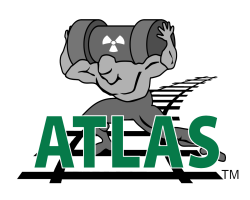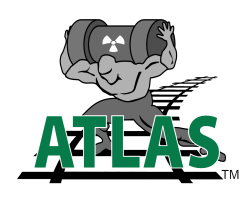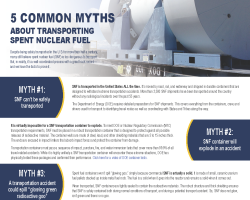Category of Content
Siting Experience Documents Only
Publication Date
Subject Matter
Keywords
DOE Atlas Railcar Project End-of-Phase 2 Final Report
DOE Atlas Railcar Project End-of-Phase 2 Final Report
Atlas Phase 2 Final Report Appendix A
Atlas Phase 2 Final Report Appendix A
This document provides a white paper detailing required changes to the DOE Atlas railcar conceptual cradle attachment components and Phase 1 conceptual cradle design due to the addition of the HI-STAR 190 SL and XL casks to the project.
Atlas Phase 3 Report - Prototype Fabrication and Delivery
Atlas Phase 3 Report - Prototype Fabrication and Delivery
The United States Department of Energy (DOE) is preparing for future large-scale transport of spent
nuclear fuel and high-level radioactive waste, which are collectively defined as High-Level Radioactive
Material (HLRM) by the Association of American Railroads (AAR). A part of this preparation includes
designing railcars to be used for the transport of HLRM.
Atlas Phase 2 Report - Preliminary Design
Atlas Phase 2 Report - Preliminary Design
The United States Department of Energy (DOE) is preparing for future large-scale transport of spent nuclear fuel and high-level radioactive waste, which are collectively defined as High-Level Radioactive Material (HLRM) by the Association of American Railroads (AAR). A part of this preparation includes designing railcars to be used for the transport of HLRM.
Mothers for Nuclear Flyer
Mothers for Nuclear Flyer
Mothers for Nuclear Informational Flyer
Respecting free, prior and informed consent: Practical guidance for governments, companies, NGOs, indigenous peoples and local communities in relation to land acquisition
Respecting free, prior and informed consent: Practical guidance for governments, companies, NGOs, indigenous peoples and local communities in relation to land acquisition
Large-scale investments in land are spreading faster than ever before across the global south. Often these investments target lands governed by customary rights that are not adequately recognized and protected under national laws, or sites where governments lack the capacity to enforce the law. Land deals that change the use of land and natural resources have wide implications for indigenous peoples and local communities who depend primarily on these resources for their livelihoods, welfare and cultural identity.
What’s Fairness Got to Do with It? Environmental Justice and the Siting of Locally Undesirable Land Uses
What’s Fairness Got to Do with It? Environmental Justice and the Siting of Locally Undesirable Land Uses
Policy makers and local land use officials have long struggled to cope with the "not in my backyard" (NIMBY) syndrome in attempting to site "locally undesirable land uses" (LULUs), such as homeless shelters, drug or alcohol treatment centers, and waste disposal facilities. In general, LULUs are considered beneficial to society at large,' and many agree that they should be located somewhere. Those same citizens protest vigorously, however, when such a use is sited near their homes. This protest is quite rational.
Community Involvement Plan: Area IV, Santa Susana Field Laboratory
Community Involvement Plan: Area IV, Santa Susana Field Laboratory
As a result of the 2007 ruling by the U.S. District Court of Northern California that the DOE must prepare an Environmental Impact Statement (EIS) to evaluate alternatives for cleanup of Area IV of the SSFL, DOE has implemented major changes in its management of SSFL Area IV. As an initial step, this community involvement plan (CIP) outlines a series of activities and programs that intend to engage the public, establish transparency in DOE actions and decisions, and increase input from the community.
Respecting free, prior and informed consent: Practical guidance for governments, companies, NGOs, indigenous peoples and local communities in relation to land acquisition
Respecting free, prior and informed consent: Practical guidance for governments, companies, NGOs, indigenous peoples and local communities in relation to land acquisition
The FAO Governance of Tenure Technical Guides are part of FAO’s initiative to help develop capacities to improve tenure governance and thereby assist countries in applying the Voluntary Guidelines on the Responsible Governance of Tenure of Land, Fisheries and Forests in the Context of National Food Security. The FAO Governance of Tenure Technical Guides are prepared by technical specialists and can be used by a range of actors.
United Nations Declaration on the Rights of Indigenous Peoples
United Nations Declaration on the Rights of Indigenous Peoples
The General Assembly, Taking note of the recommendation of the Human Rights Council contained in its resolution 1/2 of 29 June 20061 , by which the Council adopted the text of the United Nations Declaration on the Rights of Indigenous Peoples, Recalling its resolution 61/178 of 20 December 2006, by which it decided to defer consideration of and action on the Declaration to allow time for further consultations thereon, and also decided to conclude its consideration before the end of the sixty-first session of the General Assembly, 1 See Official Records of the General Assembly, Sixty-first S
Transportation Planning: Indigenous Dialogue
Transportation Planning: Indigenous Dialogue
In 2019, the NWMO commissioned Maawandoon Inc to lead Indigenous Dialogue session to support NWMO’s transportation planning for the long-term care of Canada’s used nuclear fuel. This research built upon and complemented public attitude research carried out in 2017 and 2018. The research methodology consisted of 7 Indigenous dialogue sessions and attendance at 3 Indigenous Annual General Assemblies (AGA)/meetings with dialogue components.
Views and Attitudes toward Nuclear Waste: National Survey Final Report
Views and Attitudes toward Nuclear Waste: National Survey Final Report
In 2002, the federal government passed a law to create the Nuclear Waste Management Organization, also known by its initials NWMO. The Nuclear Waste Management Organization (NWMO) was established by Ontario Power Generation Inc., Hydro-Québec and New Brunswick Power Corporation in accordance with the Nuclear Fuel Waste Act (NFWA) to assume responsibility for the long-term management of Canada’s used nuclear fuel. More specifically, the NWMO’s initial objective was to recommend a long-term approach for managing used nuclear fuel produced by Canada’s electricity generators.
Topical Analysis of Nuclear Experts' Perceptions of Publics, Nuclear Energy, and Sustainable Futures
Topical Analysis of Nuclear Experts' Perceptions of Publics, Nuclear Energy, and Sustainable Futures
Nuclear energy experts consider commercial power from fission to be a strong contender to help mitigate the increasing effects of climate change, in part due to its low-to-no carbon emissions. Nevertheless, nuclear energy's history, including meltdowns such as Three Mile Island, Chernobyl, and Fukushima, and dumping in sacred Indigenous land such as Yucca Mountain, raises important concerns in public deliberation over nuclear power.
Place Identity: How Far Have We Come in Exploring Its Meanings?
Place Identity: How Far Have We Come in Exploring Its Meanings?
In order to synthesize the extensively studied place identities and their meanings, this paper reviews how researchers have conceived and deconstructed place identity. CiteSpace, a scientometric tool for visualizing and analyzing trends and patterns in scientific literature, is used to identify the active topics and new developments of publications in place identity. The data set input into CiteSpace consists of 1,011 bibliographic records retrieved from the core database of Web of Science with a title search of the articles published between 1985 and July 2019.
Free, Prior and Informed Consent in Fulfilling the Constitutional Rights of Citizens in the Mining Sector
Free, Prior and Informed Consent in Fulfilling the Constitutional Rights of Citizens in the Mining Sector
Based on data from the Directorate General of Mineral and Coal, Ministry of Energy and Mineral Resources, in 2017, there are 9,353 Mining Business Licenses (MBL) with 9,074 MBLs entered in the DG of Mineral and Coal database. Of these, 6,565 MBLs passed the CnC requirements, while the remaining 2,509 MBLs were categorized as non-CnC. The focus of the problems studied are: (1) What is the Direction of Changes in Government Policy in the Mining Sector?
Nuclear power and the public: an update of collected research on nuclear power
Nuclear power and the public: an update of collected research on nuclear power
The purpose of this research was to collect, analyze, and summarize all of the nuclear power-related surveys conducted in the United States through June, 1981, that we could obtain. The surveys collected were national, statewide, and areawide in scope. Slightly over 100 surveys were collected for an earlier, similar effort carried out in 1977. About 130 new surveys were added to the earlier survey data. Thus, about 230 surveys were screened for inclusion in this report.
Social Distrust: Implications and Recommendation for Spent Nuclear Fuel and High Level Radioactive Waste Management
Social Distrust: Implications and Recommendation for Spent Nuclear Fuel and High Level Radioactive Waste Management
This review develops recommendations for moving forward with SNF and HLW management in a context of social distrust, while also working to regain social trust over the long term. We begin with a short overview of social trust and confidence, including definitions, how it is built and destroyed, and trends in social trust in the US. We then turn to the implications of dilemmas and trade-offs that arise for the design and implementation of a system that has requirements in addition to trust and confidence.
Communicating Risks and Benefits: An Evidence-Based User's Guide
Communicating Risks and Benefits: An Evidence-Based User's Guide
Effective risk communication is essential to the well-being of any organization and those people who depend on it. Ineffective communication can cost lives, money, and reputations. Communicating Risks and Benefits: An Evidence-Based User's Guide provides the scientific foundations for effective communication.
Science based responses to social myths on nuclear energy
Science based responses to social myths on nuclear energy
In order to promote a sound basis for considering the role of nuclear in climate change, this review spans the technical topics of social and political debate surrounding nuclear energy with a focus on the objective science of these issues including nuclear waste, accidents and overall risk. Novel aspects include the emergence of nuclear energy as being potentially renewable and the antithesis of Fukushima being an argument for the unacceptable risks associated with the use of nuclear energy.
Going the Distance? The Safe Transport of Spent Nuclear Fuel and High-Level Radioactive Waste in the United States - Summary
Going the Distance? The Safe Transport of Spent Nuclear Fuel and High-Level Radioactive Waste in the United States - Summary
This new report from the National Research Council’s Nuclear and Radiation Studies Board (NRSB) and the Transportation Research Board reviews the risks and technical and societal concerns for the transport of spent nuclear fuel and high-level radioactive waste in the United States. Shipments are expected to increase as the U.S. Department of Energy opens a repository for spent fuel and high-level waste at Yucca Mountain, and the commercial nuclear industry considers constructing a facility in Utah for temporary storage of spent fuel from some of its nuclear waste plants.
Summary of Consolidated Interim Storage Advantages and Disadvantages from an Integrated Systems Perspective from Prior Reports and Studies
Summary of Consolidated Interim Storage Advantages and Disadvantages from an Integrated Systems Perspective from Prior Reports and Studies
The question of whether centralized storage of civilian spent nuclear fuel (SNF) should be part of the federal waste management system as an intermediate step before permanent disposal has been debated for more than four decades. Centralized storage facilities were included as a potential component of the U.S. spent fuel management system in the Nuclear Waste Policy Act of 1982 (NWPA), but the NWPA did not identify these facilities as being essential.
ATLAS Railcar - Ft Steele Bridge Crossing
ATLAS Railcar - Ft Steele Bridge Crossing
Video of the Atlas Railcar traveling over the Ft. Steele Bridge Crossing
One of the Safest Trains Ever Built? Atlas Railcar Completes Final Testing
One of the Safest Trains Ever Built? Atlas Railcar Completes Final Testing
Video of the recently completed 1,600-mile round-trip journey from Colorado to Idaho to wrap up final testing on the Atlas railcar.
5 Common Myths about Transporting Spent Nuclear Fuel flyer
5 Common Myths about Transporting Spent Nuclear Fuel flyer
Despite being safely transported in the U.S. for more than half a century, many still believe spent nuclear fuel (SNF) is too dangerous to transport. But, in reality, it’s a well-coordinated process with a great track record—and we have the facts to prove it.







